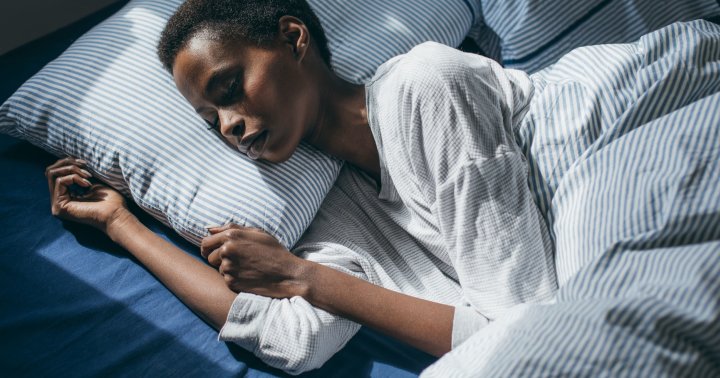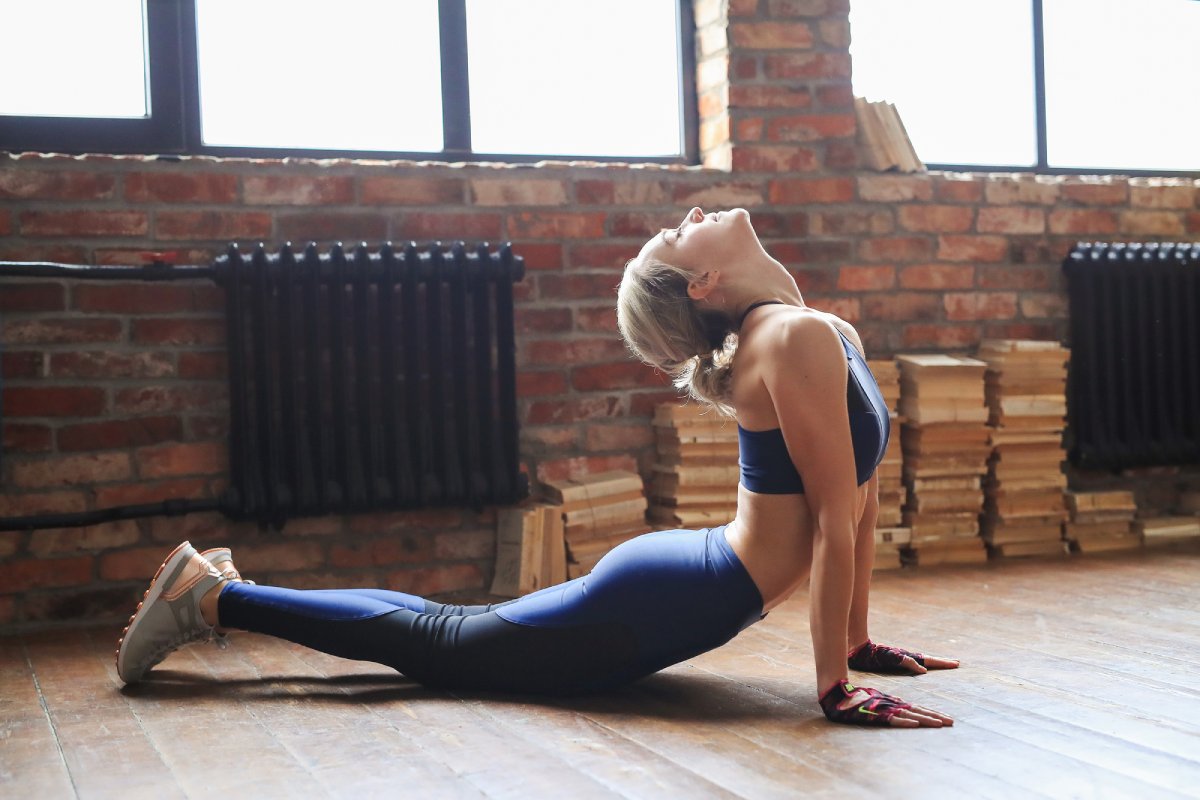Feeling Sore After Yoga? Here’s How to Soothe Your Muscles and Boost Recovery
The post Feeling Sore After Yoga? Here’s How to Soothe Your Muscles and Boost Recovery appeared first on The Yoga Nomads.

Quick Tip: Feeling sore after yoga is normal and indicates muscle growth and increased flexibility.
It seems strange to feel sore after an entire yoga class of deep stretching and meditative flows. But in the 12-48 hours following a yoga class, you may feel the same post workout soreness you experience after the gym or a new sport. Before you jump into another hot yoga class to relieve those tight muscles, consider that you may just need to give your body time to heal.
Whether you’re just starting your yoga practice, returning to the mat after a long break, or trying out a more intense yoga style, be assured that soreness after yoga is completely normal. Let’s dig into the deeper causes of sore muscles and how to speed up your recovery!
Is Feeling Stiff After Yoga Normal?
Yoga is known for its calming affect on the mind and body, so muscle soreness after a yoga class is a bit alarming. Shouldn’t you feel completely relaxed and stretched out?
Actually, a stiff feeling after a yoga session could be a sign that you challenged yourself and are building muscle. This is especially normal for beginner yogis or people who are trying out more intense yoga styles like Vinyasa, Ashtanga, or Bikram.
Just like any good workout, soreness after yoga is typically a sign that your body is becoming stronger and more flexible while adjusting to the new form of exercise.
However, intense pain is not normal. If you feel any muscle pain or intense discomfort, it could be an early sign of an injury, like overextending your muscles, over-stretching, or a minor sprain. Consult your health practitioner for guidance.
Why is My Body So Sore After Yoga?
Delayed onset muscle soreness is the most common form of muscle soreness after yoga. You usually start to feel it about 12 to 48 hours after you exercise. Soreness is a sign that your muscles worked hard to hold you in yoga poses and are now working to mend themselves.
Traditional Hatha and Yin yoga are low-impact forms of exercise, however many modern adaptations of Vinyasa, Ashtanga, and hot yoga provide a more intense workout. Regardless of the class style, the eccentric muscle contractions (lengthening) while holding poses causes microscopic tears in your muscle fascia.
The fascial tissues are like a thin fibrous web that surrounds your muscle groups and connects every part of your body. As you stretch and challenge muscles, these tiny tears actually lead to more strength and flexibility in the long run.
The micro-muscle tears signal your body to put off a slight inflammatory response. When it comes to processed foods or allergic reactions, inflammation has a bad or unhealthy connotation, but this form of micro-inflammatory response is actually what causes your muscles to build back stronger than before. You feel sore because the fascia and muscles are repairing those micro-tears to facilitate muscle growth.
Bottom Line: Muscle damage from a good workout is what causes soreness after yoga. It will go away on its own or you can take steps to ease muscle tension.
How to Relieve Sore Muscles After Yoga
Hardcore athletes and fitness junkies have long known these secrets to speeding up muscle recovery (hint: a lot of it has to do with simple rest). Once you realize that soreness after yoga is perfectly normal, it’s time to ease the pain so you can get back to your favorite yoga classes.
If you’re craving quick relief from muscle soreness or muscle spasms, you can do these easy home self-care practices to help your body restore its muscle fascia more quickly:
Hydrate
Forgetting to drink extra water is one of the biggest mistakes that beginners make when they start to practice yoga. Yoga may not feel like a crazy 10 mile run or weight lifting workout, but it still requires plenty of extra water intake. Hydration ensures that your body can flush out metabolic waste (that causes muscle soreness) and any toxins you have yet to sweat out.
Bottom Line: More hydration = less soreness
The National Academies of Sciences suggests 2.7-3.7 liters of water daily. This is almost 1 gallon of water per day! Most people are chronically dehydrated and fall way short of this. If you just finished a hot yoga class, we recommend staying even more hydrated. Interestingly, this hydration is most important before and after your yoga class.
As a rule of thumb:
Drink 8-16 ounces of water an hour before yoga class. Don’t drink too much water right before yoga (or you may be going to the bathroom and feeling bloated.) After class, continue to drink several water bottles throughout the day. Drink another large glass of water before bed to facilitate muscle recovery.Eat Balanced Meals
It should come as no surprise that basic nutrition is essential for relieving muscle soreness.
The yoga guru BKS Iyengar recommends waiting at least 30 minutes to eat after yoga. Then, it’s time to replenish your electrolytes, vitamins, healthy fats, and protein reserves.
Our favorite after-yoga snacks include:
Fresh fruit- watermelon is great for hydration! We prefer whole fruits to juices because you get the natural plant fibers. Kombucha! We love GT’s Synergy. Almond butter and banana toast A fresh fruit smoothie with Orgain Organic Protein Powder Egg and avocado wrap or toast Greek yogurt and Purely Elizabeth Grain-Free Granola GoMacro Organic Protein Bars Keto-Friendly EPIC Meat Bars Hard boiled egg Garden of Life Grass Fed Collagen Protein with beverage of choiceSleep
Quality sleep is the secret to speed healing your muscles and your brain. It’s true that yoga can boost your energy and help you lose weight, but you can’t enjoy these benefits without enough sleep. As you rest, your body can repair damaged tissue and reduce soreness. Make sure you get a full eight hours of quality sleep.
Pro Tip: Reset your Circadian Rhythm by watching the sunset and avoiding the blue light from devices at least an hour before bed. of quality sleep. Blue light actually triggers your body to stop producing melatonin when it needs it. Blue light blocking glasses can help protect your body from staying up when you should be sleeping. This will help you get back in a routine
Foam Roller
Foam rolling for 20 minutes after your workout is scientifically proven to reduce delayed onset muscle soreness. It is a popular practice among athletes who need a speed recovery or people in physical therapy who feel pain from daily activities. It also works great for eradicating soreness after yoga.
As you roll the foam cylinder beneath your legs, abs, or back, it acts as a myofascial release that passively stretches and reduces muscle tension.
This ultra dense ribbed foam roller feels absolutely divine on a sore back or legs!
Hot Bath
A warm bath, hot tub, or even a sauna can help heat up your muscles and reduce muscle soreness. If you want to take the rejuvenation to the next level, try an Epsom salt bath. Epsom salt (magnesium sulfate) soaks are one of the best ways to absorb magnesium in your body. Magnesium is an essential electrolyte that ensure nerve and enzyme function, reduces inflammation, and relieves overall pain.
Add 2 cups of Epsom salt for a standard size bathtub of warm water. Soak for at least 15 minutes.
Gentle Exercise
While you shouldn’t hit the gym or another Bikram class when you’re sore after yoga practice, gentle exercise can help loosen things up. A brisk walk or a gentle stretching can work wonders for relieving tightness.
Take BCAA Supplements
Fitness experts have long used supplements to optimize their workouts. If your yoga practice is more intense than the average flow, you may benefit from taking BCAA (branched chain amino acids) supplements. Amino acids are the building blocks of protein, which are essential for building lean muscle. We love this powdered product called Naked BCAAs that you can easily add to smoothies or drinks.
One study from the Journal of the International Society of Sports Nutrition found that taking BCAA and Taurine supplements both before and after a workout can help reduce muscle soreness.
Return to the Mat
After a day of recovery, you can return to your yoga practice with an easygoing flow or light stretching. Avoid any prolonged balancing poses, muscle-straining power poses, or advanced inversions. Instead, stick to basic restorative poses that will stretch you out and ease the soreness:
These calming postures increase blood flow and reduce pain.
Get a Massage
A gentle massage with essential oils and lotion can work wonders to reduce stiffness and increase circulation. Ask a friend or significant other to work out some pain points as you breathe or book a professional sports massage that will help you sustainable build more muscle as you return to your daily practice and other workouts.
The Role of Nutrition in Muscle Recovery
The role of nutrition in muscle recovery is crucial, especially for those who are new to yoga. When you first start practicing yoga, it may seem like all you need to do is listen to your body and follow the instructions of your yoga instructor. However, if you’re feeling sore after your yoga session, it’s important to understand that muscles don’t recover as quickly as we may think.
There’s a good chance that you may experience muscle soreness after a yoga practice, especially if you push yourself beyond your range of motion. While post-yoga soreness is common, chronic pain or severe muscle pain after yoga can indicate overexertion. To prevent soreness after yoga and promote recovery, it’s important to nourish your body with the right nutrients.
Yoga can make your muscles sore, but it can also help reduce soreness after yoga. Incorporating specific nutrients into your diet can help your muscles recover faster and cope with soreness. For example, foods rich in protein can aid in muscle repair and growth, while foods high in antioxidants can reduce inflammation and discomfort after yoga.
By fueling your body with the right nutrients, you can speed up the recovery process and prevent muscle pain after yoga.
Significance of Post Yoga Nutrition
Nutrition plays a vital role in aiding muscle recovery following yoga practice. Your food choices can greatly influence the speed at which your muscles heal and the level of soreness you experience. Proper nutrition is key to repairing muscle fibers and replenishing energy reserves.
Essential Nutrients for Recovery
Protein is crucial for muscle repair, as it provides the necessary building blocks for muscle recovery and growth. Carbohydrates are also essential as they help replenish depleted glycogen stores from exercise. Healthy fats support overall cellular function and help reduce inflammation.
Recommended Post Yoga Snacks
After practicing yoga, it’s advisable to choose snacks that offer a mix of protein, carbohydrates and healthy fats. Some excellent options include a protein smoothie, a banana with almond butter or Greek yogurt with granola. These snacks provide a well rounded blend of nutrients to facilitate recovery.
Timing Is Key
The timing of your post yoga meal or snack is significant as well. It’s best to consume food within 30 minutes to an hour after your session when your muscles are most receptive to nutrients, optimizing the recovery process.
Foods to Steer Clear Of
Avoid processed foods and excessive sugar as they can lead to increased inflammation and hinder the recovery process. Opt for wholesome, nutrient rich foods to aid in your body’s recovery.
By prioritizing good nutrition, you can alleviate muscle soreness and elevate your overall yoga practice.
The Impact of Fascia on Muscle Soreness from Yoga Practice
When discussing the discomfort in muscles post yoga, we often fail to recognize the significance of fascia. Fascia, a thin layer of connective tissue enveloping muscles, bones and organs, plays a vital role in enhancing flexibility and facilitating movement within the body.
Understanding Fascia
Think of fascia as a network that binds everything together. It offers structural support and aids in distributing force throughout your body. Engaging in yoga poses involves not only working your muscles but also stretching and engaging your fascia.
The Role of Fascia in Soreness
While practicing yoga, particularly in poses that involve deep stretching or sustained holds, your fascia experiences strain. This can result in minor tears within the fascial structure, akin to what occurs with muscle tissue. These small tears contribute to the soreness experienced post yoga.
Techniques for Releasing Fascial Tension
To alleviate soreness, it is beneficial to integrate techniques for releasing tension within the fascia into your routine. Foam rolling is a commonly used method; however, you can also utilize tools such as massage balls or even your hands. Gently massaging areas of discomfort can aid in releasing tension within the fascia and promoting quicker recovery.
My Experience with Fascial Health
I’ve noticed that paying attention to fascial health has really helped me manage any soreness after doing yoga. Incorporating simple techniques like foam rolling and specific massages has had a significant impact. It’s not just about the muscles; caring for your fascia can enhance your yoga practice, making it more comfortable and effective.
Recognizing the importance of fascia introduces a new dimension to your recovery plan. It can truly revolutionize how you approach reducing soreness and maximizing the advantages of practicing yoga.
Things to Avoid When You Feel Sore
Feeling sore is a simple signal that your body needs time to heal. For the following days of recovery, avoid:
Strenuous workouts: Running, cardio, or heavy weight lifting could cause more strain. Over-stretching: This can overextend sore muscles and cause more pain. Excessive caffeine: Caffeine and energy drinks can further dehydrate your body and prevent you from getting much-needed rest. Anti inflammatory drugs: These actually slow your recovery and make it harder for you to experience muscle growth.After you start feeling sore, wait 1-3 days before your next yoga class. Your body will thank you for the rest and you will come back stronger, more flexible, and more relaxed than before!
Namaste!
Pop quiz! 🧘🤔
Feeling sore after yoga is a sign that you are building muscle.
Drinking water before and after yoga has no effect on muscle soreness.
Intense pain after yoga is normal and should be ignored.
Thanks for your feedback!

 ValVades
ValVades 

































